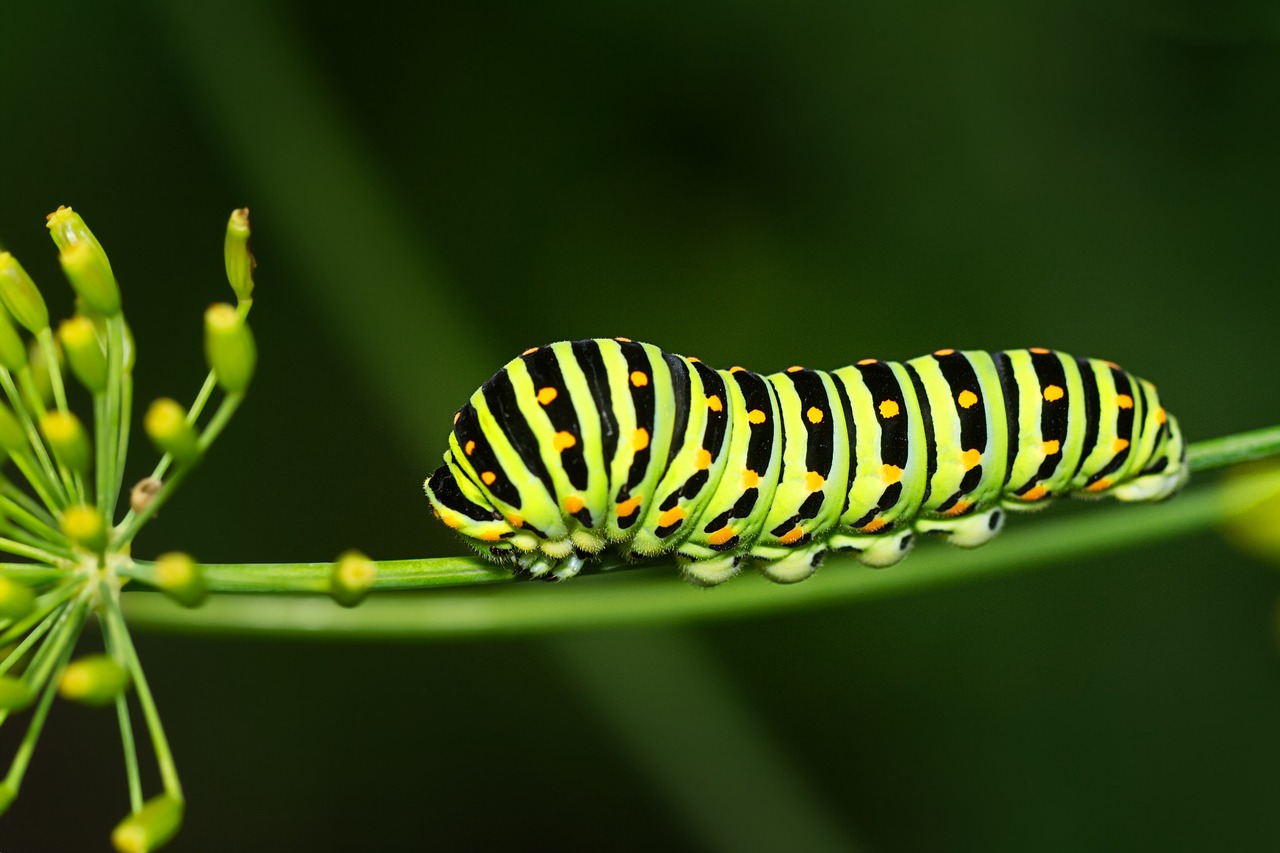Here are 20 interesting facts about caterpillars
-
- Caterpillars have just one job—to eat. During their larval stage, they must consume enough food to sustain themselves through their pupal stage and into adulthood. Some caterpillars can eat 27,000 times their body weight in their lifetime.
- Caterpillars increase their body mass by as much as 1,000 times or more. Within a few weeks, they grow exponentially and molt multiple times as they gain size and mass. Most caterpillars go through 5 to 6 instars before pupating.
- A caterpillar’s first meal is usually its eggshell. The outer layer of the egg, called the chorion, is rich in protein and provides the new larva with a nutritious start.
- Caterpillars have as many as 4,000 muscles in their body. That’s more than six times the number of muscles in humans. The caterpillar’s head capsule alone consists of 248 individual muscles. About 70 muscles control each body segment.
- Caterpillars have 12 eyes. On each side of its head, a caterpillar has 6 tiny eyelets, called stemmata, arranged in a semi-circle. The stemmata help the caterpillar differentiate between light and dark, but they do not have good vision.
- Caterpillars produce silk. Using modified salivary glands along the sides of their mouth, caterpillars can produce silk as needed. Some caterpillars use silk to disperse by ballooning from the treetops on a silken thread. Others construct silk tents or cocoons in which they live or pupate.
- Similar to adult moths and butterflies, caterpillars possess six true legs. The other legs that you see on a caterpillar are false legs (called prolegs) that help them climb and move around plant surfaces. Prolegs have tiny hooks to enable them to grasp on the surfaces and avoid sliding and falling.
- The assassin caterpillar can kill humans. The assassin caterpillar, also known as giant silkworm moth, has caused many human deaths in South Africa (especially in Brazil). Its venom can cause a person to bleed to death. The caterpillar’s scientific name is Lonomia obliqua.
- Caterpillars are capable of mimicking a snake to protect themselves from predators. They arrange themselves in a row which comprises about 300 caterpillars so that they resemble a snake. Some caterpillars also have markings or appendages that look like snake eyes or heads.
- Caterpillars can make sounds. Some caterpillars can produce noises by rubbing their body parts together or by forcing air out of their spiracles (openings for breathing). These sounds can serve as warning signals to predators or communication signals to other caterpillars.
- Caterpillars can regenerate lost body parts. If a caterpillar loses a leg or an antenna due to injury or predation, it can regrow it during the next molt. This ability is more common in younger caterpillars than older ones.
- Caterpillars can change color. Some caterpillars can alter their coloration or pattern depending on their surroundings or diet. This helps them blend in with their environment and avoid detection by predators.
- Caterpillars can form social groups. Some caterpillars live and feed together in colonies, sharing silk shelters or tents. They may also cooperate with each other by sending signals or cues about food sources or threats.
- Caterpillars can detect vibrations. Caterpillars have tiny hairs called setae that cover their body. These hairs are connected to nerve cells that allow them to sense touch, smell, taste and vibrations.
- Caterpillars can spray chemicals. Some caterpillars have glands that can secrete defensive substances when they are threatened. These chemicals can be irritating, foul-smelling or toxic to predators or parasites.
- Caterpillars can be parasitized by other insects. Some wasps and flies lay their eggs inside or on the surface of caterpillars. When the eggs hatch, the larvae feed on the caterpillar’s tissues, eventually killing it.
- Caterpillars can be infected by viruses that turn them into zombies. Some viruses can manipulate the behavior of caterpillars by making them climb to the top of plants and stay there until they die. This allows the virus to spread more easily through raindrops or wind.
- Caterpillars can be cannibalistic. Some caterpillars may eat other caterpillars of the same or different species when food is scarce or when they are overcrowded. This may reduce competition for resources or provide extra nutrition.
- Caterpillars can be herbivores, carnivores or omnivores. Most caterpillars feed on plant leaves, stems, flowers or fruits, but some are predators that hunt and eat other insects such as aphids or ants. Some are scavengers that feed on dead animals or feces.
- Caterpillars can be beneficial or harmful to humans. Some caterpillars are important pollinators of plants that humans use for food, medicine or other purposes. Some are also sources of silk, dye or bioactive compounds. However, some caterpillars are pests that damage crops or trees, cause allergic reactions or transmit diseases.
Facebook Comments


































